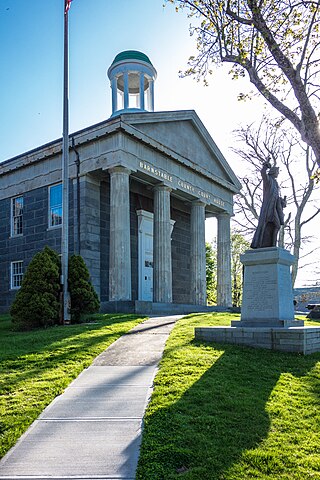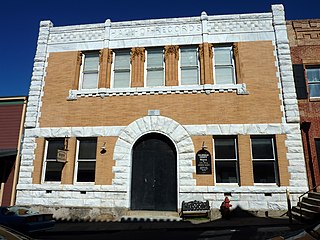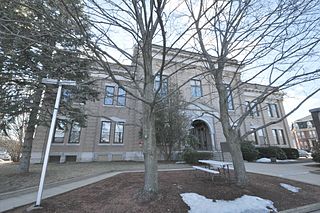
The Dubuque County Courthouse is located on Central Avenue, between 7th and 8th Streets, in Dubuque, Iowa, United States. The current structure was built from 1891 to 1893 to replace an earlier building. These are believed to be the only two structures to house the county courts and administrative offices.

The Bristol County Courthouse Complex Historic District contains three historic buildings located along Court Street in Taunton, Massachusetts, including the Bristol County Superior Courthouse, the Bristol County Registry of Deeds and the former First District Courthouse. The city's Korean War and World War II Memorials are also located on the lawn in front of the superior courthouse. The Bristol County Courthouse Complex directly abuts the Taunton Green Historic District, the City's central square.

The Woodbury County Courthouse is located at 620 Douglas Street in Sioux City, the county seat of Woodbury County, Iowa, United States. It is regarded as "one of the finest Prairie School buildings in the United States" and has been declared a National Historic Landmark for its architecture. It is used for legal proceedings in the county.

The Norfolk County Courthouse, also known as the William D. Delahunt Courthouse, is a National Historic Landmark at 650 High Street in Dedham, Massachusetts. It currently houses the Norfolk County Superior Court. It is significant as a well-preserved Greek Revival courthouse of the 1820s, and as the site a century later of the famous Sacco-Vanzetti trial. The building was declared a National Historic Landmark in 1972, and is listed on the National Register of Historic Places. It replaced an earlier courthouse, built in 1795.

The Barnstable County Courthouse is an historic courthouse at 3195 Main Street in Barnstable, Massachusetts. The two-story Greek Revival building was built in 1831 to a design by architect Alexander Parris. It is built mostly out of Quincy granite, although its front portico and fluted Doric columns are made of wood fashioned to look like stone. The building has been expanded five times between 1879 and 1971, with each addition made in a style sensitive to its original styling, and its main courtroom features original Federal styling. The building was listed on the National Register of Historic Places in 1981, and included in the Old King's Highway Historic District in 1987. The Barnstable Superior Court is located in the building.

The Bristol County Superior Court is a historic courthouse at 441 N. Main Street in Fall River, Massachusetts. It is a monumental three story granite structure, with a five-story square tower at one corner. The oldest portion of the building, the main courthouse was designed by New Bedford architect Robert H. Slack, and was completed in 1889. Connected to the courthouse is the deed registry, a similar structure built in 1930 to a design by Fall River architect Edward M. Corbett. The building is Fall River's finest and most imposing example of Richardsonian Romanesque architecture.

The United States Courthouse, also known as the Federal Building, is a historic building located in Davenport, Iowa, United States. It has historically housed a post office, courthouse, and other offices of the United States government. The building now serves only as a federal courthouse, housing operations of the eastern division of the United States District Court for the Southern District of Iowa. In 2018, the operations of the Rock Island division of the United States District Court for the Central District of Illinois were also moved there.

The United States Customhouse is a historic custom house located at Houston in Harris County, Texas.

The Amherst Village Historic District encompasses the historic village center of Amherst, New Hampshire. Centered on the town's common, which was established about 1755, Amherst Village is one of the best examples of a late-18th to early-19th century New England village center. It is roughly bounded on the north by Foundry Street and on the south by Amherst Street, although it extends along some roads beyond both. The western boundary is roughly Davis Lane, the eastern is Mack Hill Road, Old Manchester Road, and Court House Road. The district includes the Congregational Church, built c. 1771-74, and is predominantly residential, with a large number of Georgian, Federal, and Greek Revival houses. Other notable non-residential buildings include the Farmer's Bank, a Federal-style brick building built in 1806, and the Amherst Brick School, a brick Greek Revival structure that has served as the School Administrative Unit 39 offices since 1997.

The Carroll County Court House is a historic former courthouse at 20 Courthouse Square in Ossipee, New Hampshire. Built in 1916, it is the county's oldest surviving courthouse, and a prominent local example of Colonial Revival architecture. It housed county offices until the 1970s, was a courthouse until 2004, and now houses the Ossipee Historical Society. The building was added to the National Register of Historic Places in 2007, and the New Hampshire State Register of Historic Places in 2003.

The James A. Redden Federal Courthouse, formerly the United States Post Office and Courthouse, is a federal courthouse located in Medford, Oregon, United States. Completed in 1916 under the supervision of architect Oscar Wenderoth, it houses the United States District Court for the District of Oregon. A substantial extension was completed in 1940, under the supervision of architect, Louis A. Simon. In September 1996, the United States Senate enacted a bill introduced by Oregon Senator Mark Hatfield to rename the building for long-serving District Court judge James A. Redden.

The Linn County Courthouse is located on May's Island in the middle of the Cedar River in Cedar Rapids, Iowa, United States. It, along with the Veterans Memorial Building and two other buildings, is a contributing property to the May's Island Historic District that was listed on the National Register of Historic Places in 1978. The courthouse is the third building the county has used for court functions and county administration.

The Calaveras County Courthouse is a historic courthouse built in 1867 in San Andreas, California. The brick courthouse contained the county's courtroom, jail, and sheriff's office; until 1888, executions were also conducted in the building. The building's jail held outlaw Black Bart, a notorious Northern California highwayman, during his 1883 trial. The county's Hall of Records was built in front of the courthouse in 1893; the two buildings nearly touch and are considered part of the same complex.

The Cheshire County Courthouse, located at 12 Court Street in Keene, New Hampshire, is the center of government of Cheshire County, New Hampshire. Completed in 1859 to a design by Gridley James Fox Bryant, it is believed to be the oldest courthouse in regular use in the state. It was added to the National Register of Historic Places on December 13, 1978.

The former Merrimack County Courthouse stands at 163 North Main Street in Concord, New Hampshire, the state capital and county seat of Merrimack County. The oldest part of the courthouse building is a brick and granite two story structure, completed in 1857 to serve as a town hall and court building. The city and county used the building for town offices and county courts until 1904, when the city sold its interest in the building to the county. Between 1905 and 1907 the building was extensively remodeled to plans by local architect George S. Forrest. The courthouse has been listed on the National Register of Historic Places since 1979. As of 2018, a new courthouse had been constructed to the rear of the building, and county offices were to be moved into the original building.

The City Hall of Manchester, New Hampshire, is located at 908 Elm Street, the city's principal commercial thoroughfare. The brick-and-granite three-story structure was built in 1844-45 to a design by Boston architect Edward Shaw, and is a prominent early example of the Gothic Revival style in a civic building. It was listed on the National Register of Historic Places in 1975.

The Milford Town House and Library Annex, now just the Milford Town Hall, is a historic municipal building occupying a prominent position facing the central oval in Milford, New Hampshire. It was built in 1869-70 and enlarged in 1891, and was designed by renowned architect Gridley J. F. Bryant. It is a significant local example of Italianate and Second Empire architecture. The building was listed on the National Register of Historic Places in 1988.

The Gov. John Butler Smith House, also now known as the Community Building, is a historic house at 29 School Street in Hillsborough, New Hampshire. The large Queen Anne Victorian is significant as one of few known residential works of a prolific New Hampshire architect, William M. Butterfield, and as the home of John Butler Smith, a principal owner of the local Contoocook Mills, who also served as governor of New Hampshire (1893–95). The building was listed on the National Register of Historic Places in 2002.
The Old Hancock County Buildings are a pair of Greek Revival buildings on Court Street, at a triangular intersection with U.S. Route 1 (US 1) and Maine State Route 172 in Ellsworth, Maine. Originally built in 1834 and 1838 to house Ellsworth Town Hall and the Hancock County courthouse, they are now owned and occupied by the Courthouse Art Gallery. The buildings were listed on the National Register of Historic Places in 1977.

Taliaferro County Courthouse is a historical government facility and clock tower located in downtown Crawfordville, Georgia, ninety miles (140 km) east of Atlanta and around fifty miles west of Augusta. The surrounding buildings are the Health Department, Senior Citizens building, Family Connection Center, and the Georgia Farm Bureau. It has been the official home of Taliaferro's Superior Court, and the base of the county's government, as well as other numerous administrative offices.























